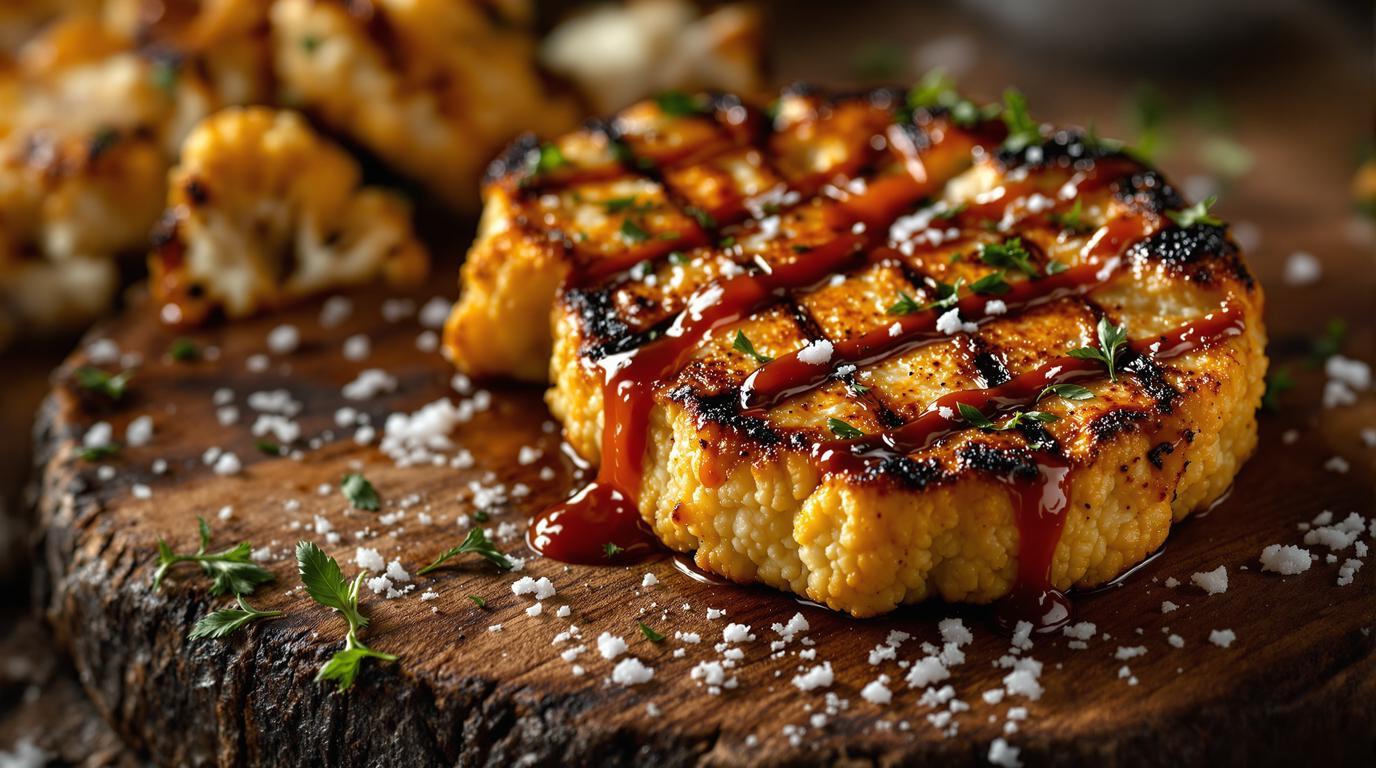The first time I made cauliflower steaks for my meat-loving grandfather, I was terrified. This man had spent 40 years perfecting his BBQ brisket! But when he took that first bite, his eyebrows shot up in surprise. “Well, I’ll be…” he muttered, before reaching for seconds. That moment taught me that plant-based cooking doesn’t have to apologize for itself—especially when you apply classic BBQ techniques to humble vegetables. This recipe transforms cauliflower into something so deeply satisfying that you might forget you’re eating something that grew from the soil rather than grazed upon it.
The Magic of Cauliflower “Steaks” 📖
Cauliflower steaks aren’t trying to be meat—they’re simply embracing the same cooking principles that make great BBQ irresistible: smoky seasoning, caramelization, and that perfect balance of char and tenderness. While certainly not traditional in the historical sense, this dish honors the spirit of Southern BBQ techniques while offering a plant-based canvas. The trick lies in treating cauliflower with the same respect you’d give a prime cut of meat—proper slicing, attentive grilling, and layering of flavors.
Essential Ingredients 🧾
For 4 servings, you’ll need:
- 1 large head of cauliflower (about 2 lbs/900g)—look for tight, cream-colored florets
- ¼ cup (60ml) olive oil—the good stuff, please
- 1½ teaspoons smoked paprika (the secret weapon!)
- 1 teaspoon garlic powder
- 1 teaspoon each kosher salt and freshly ground black pepper
- 2 tablespoons quality BBQ sauce (I prefer one with molasses notes)
Can’t find smoked paprika? Mix 1 teaspoon regular paprika with a few drops of liquid smoke. It’s not identical, but it’ll get you that essential smokiness that makes this dish special. For a similar smoky experience, consider how paprika transforms other plant-based dishes too.
Step-by-Step Instructions 📝
- Prep the cauliflower: Remove leaves and trim the stem flat, keeping the head intact. Standing the cauliflower on its stem, cut vertically into 1½-inch thick slabs. You’ll likely get 3-4 “steaks” from the center, with loose florets falling away (save these for roasting later).
- Create your spice rub: In a small bowl, whisk together olive oil, smoked paprika, garlic powder, salt, and pepper until well combined.
- Preheat your grill: Heat to medium (350°F/175°C). Oil the grates thoroughly—this is crucial.
- Season: Using a pastry brush, generously coat both sides of each cauliflower steak with the spice oil.
- Grill with patience: Place steaks on the grill and resist the urge to move them for 5 minutes. Gently flip once, then brush the tops with BBQ sauce. Cook another 5-7 minutes until tender with definitive grill marks.
- Finish with flair: In a small saucepan, warm any remaining BBQ sauce until slightly thickened. Plate the steaks and drizzle with the thickened sauce.
Chef’s Secret Techniques 🤫
The difference between a good cauliflower steak and a great one lies in technique. First, always choose the largest cauliflower head you can find—it’s the only way to get decent-sized steaks. Second, treat your grill grates like fine cookware: preheat thoroughly and oil generously to prevent sticking.
Chef’s Note: The real genius move happens after you flip—that’s when you brush with BBQ sauce. If you apply sauce too early, you’ll burn it; too late, and you won’t develop that glorious caramelization. Timing matters more than you might think.
I’ve seen home cooks make the same mistakes: flipping too often (which breaks the steaks), cutting too thin (which means no structure), or drowning in sauce (which creates steam instead of char). Remember, we’re after steaks, not cauliflower soup!
Serving & Presentation Tips 🍽️
These steaks deserve proper presentation. Serve them on warmed plates with the caramelized side up. I like to finish with a light sprinkle of flaky sea salt and fresh herbs. For sides, think classic BBQ companions: creamy coleslaw, baked beans, or grilled corn. For wine, a Cabernet Sauvignon stands up beautifully to the smoky notes, while a sparkling rosé offers a delightful contrast.
If you’re looking to expand your plant-based repertoire, this approach pairs wonderfully with other hearty vegetables. Much like my grandmother’s waste-not approach to cooking, use those loose cauliflower florets in a stir-fry or roast them as a snack.
What I love about this recipe is how it bridges worlds—satisfying enough for dedicated carnivores (like those who’d enjoy slow-braised meats) while celebrating vegetables on their own terms. It’s a perfect gateway dish for those exploring more plant-focused eating, just as cashew chicken might introduce someone to Indian flavors.
Remember, good cooking isn’t about strict rules—it’s about understanding principles. Master this technique, and you’ll start seeing possibilities everywhere. That’s how cooking traditions evolve—one curious cook at a time, just like those who’ve been making Southern soul food for generations.
